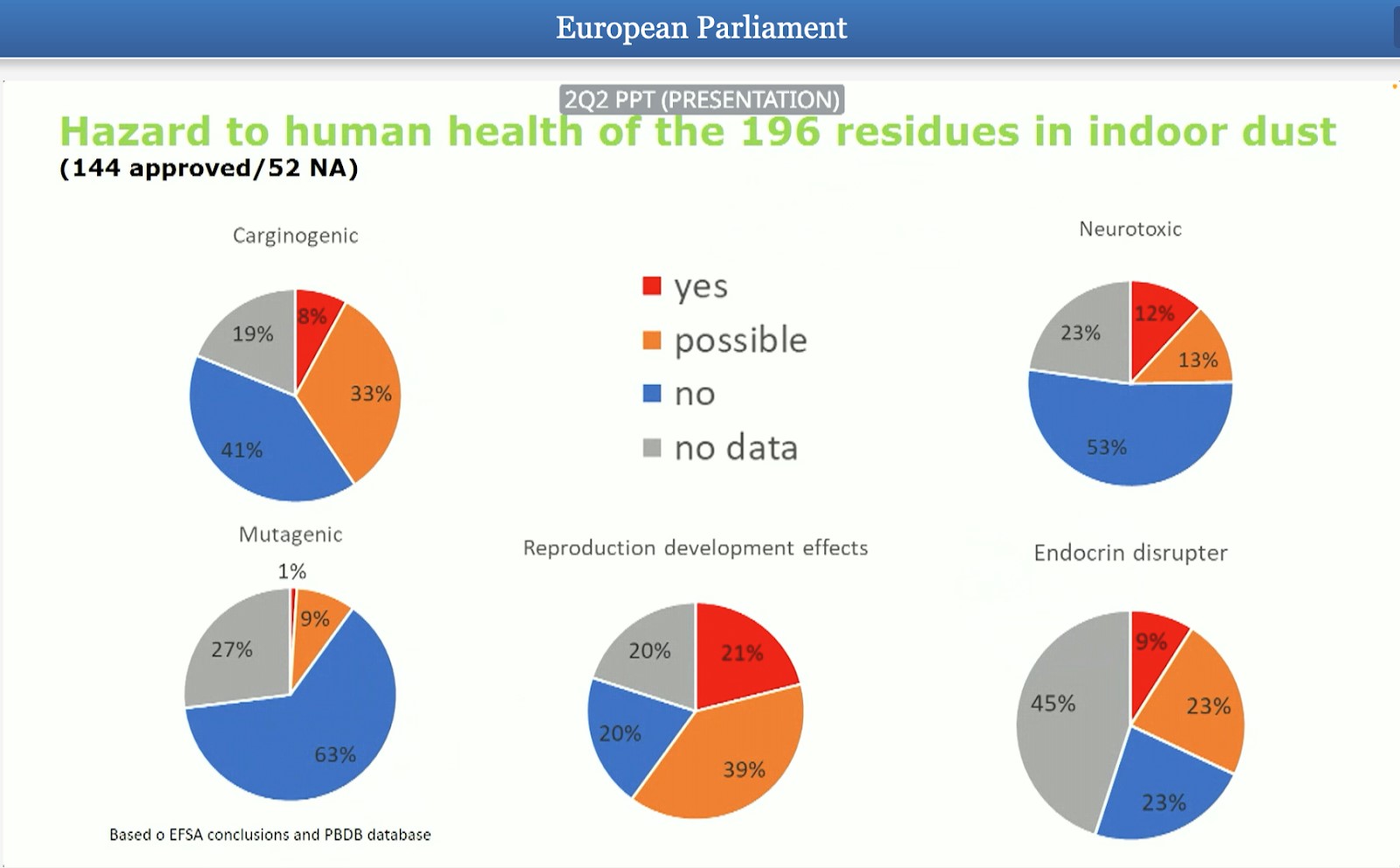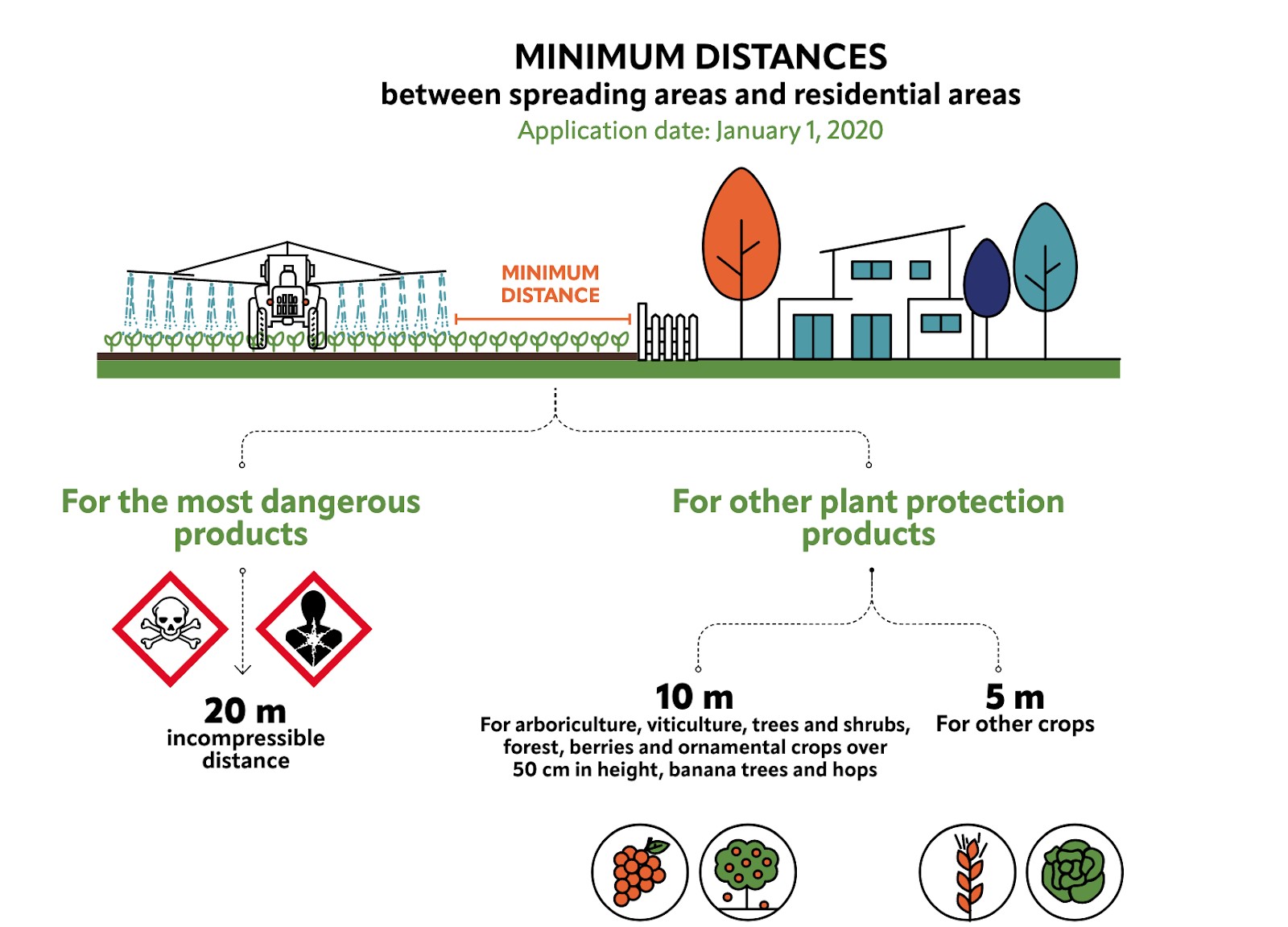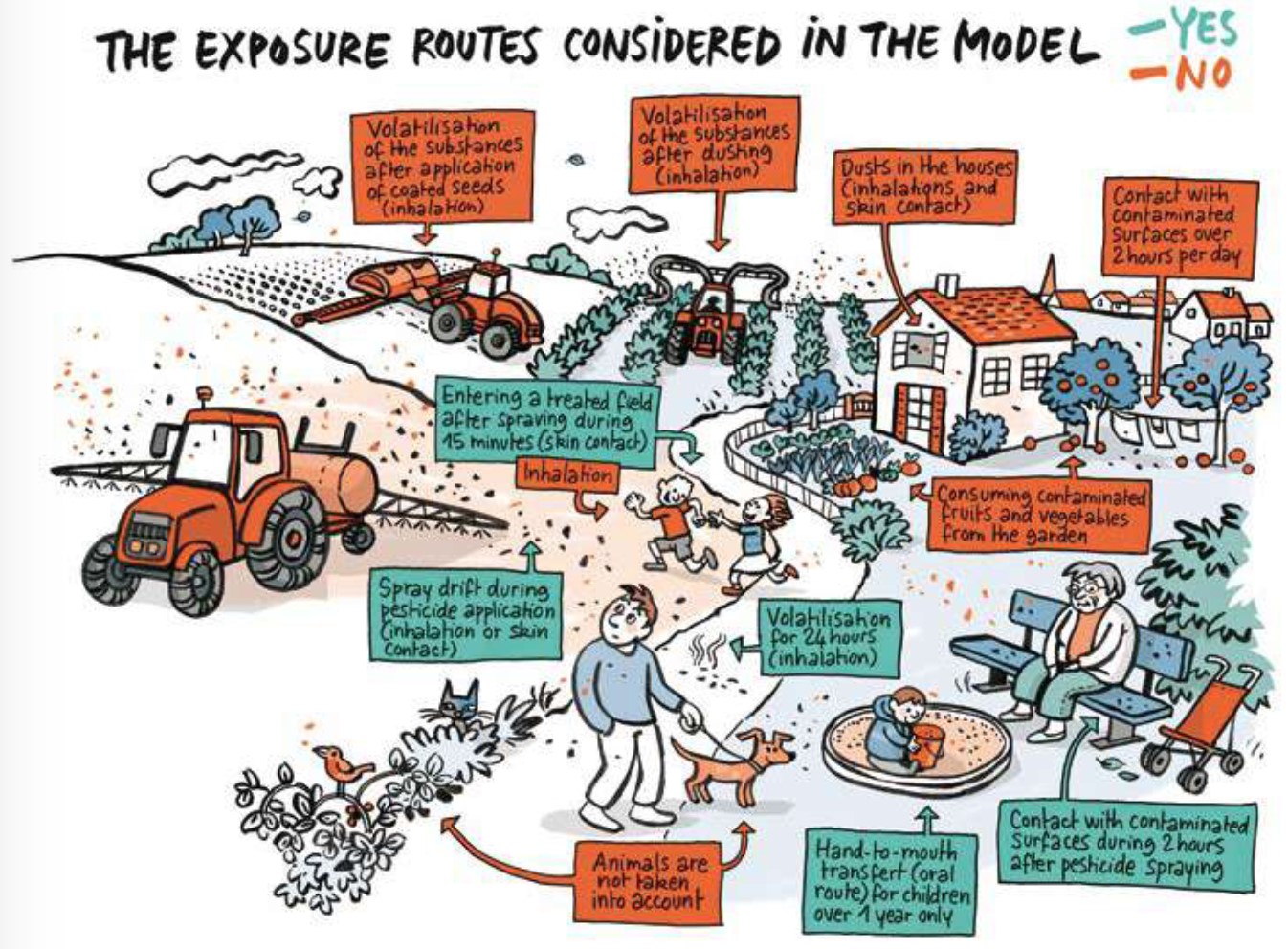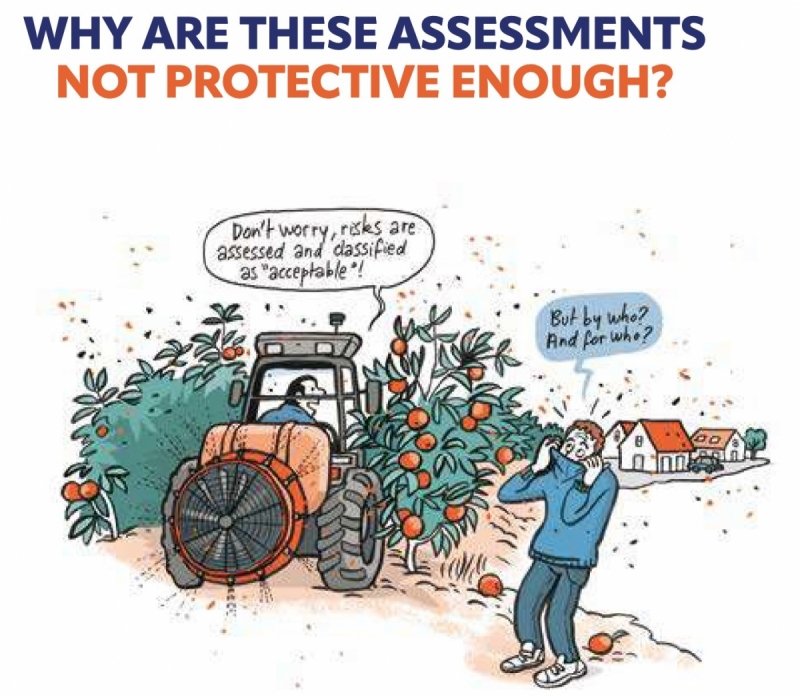A hot topic in pesticide use: how to protect citizens, water and nature from the spread of these toxic chemicals? If pesticides are allowed, what minimum buffer zone should be applied? The recent proposal from the European Commission for pesticide reduction (SUR) says 3 metres for sensitive areas. What is the scientific basis of this proposal? There are many studies that prove this is far from sufficient and organisations call for much larger zones. In South Tyrol in Italy 30 metre buffer zones are applied and even they are not enough. Smaller buffer zones in France and Belgium are contested in court. Our French member Générations Futures shows that the risk assessment developed by the European Food and Safety Authority EFSA is biased and does not protect the most vulnerable. This article is an overview of available knowledge, to help understand how we can better protect health and environment.
Pesticides do drift, even if preventive measures are taken. Pesticides are found far away from the places where they are applied, not only in people’s gardens and homes but also in children's playgrounds, sport fields and in nature reserves. They contaminate soil, water, and nature. They harm biodiversity and people’s health. The substances are inhaled directly from the air or in dust particles, but they can also be absorbed through the skin in case of direct exposure. This comes on top of constant exposure to pesticide residues in food.
Even highly toxic and very volatile Pesticides like the herbicide pendimethalin are still allowed in all EU countries, despite the fact they translocate hundreds of metres away from their spraying site. It is on the list of ‘Candidates for Substitution’, but substitution never happens and intoxications remain. In this sense the authorisations seem to be just as persistent as the pesticides themselves. In our Ban Toxic 12 campaign we state that these most harmful pesticides must go - now!
But there are many more pesticides, often very toxic and harmful in extremely low doses, as we will see below. The negative effects on health become clearer with each study. Committees of concerned citizens have been formed in various countries to assess their real exposure. Measurements give a disturbing image as we will see in studies in studies in Italy and the Netherlands. These findings are now confirmed by a broad EU funded study with samples taken in agricultural areas in 10 EU countries.
South Tyrol Italy: Children's playgrounds contaminated with pesticide drift all year round
Researchers in the Italian province South Tyrol looked into the presence of pesticides in children's playgrounds in the area where apples are grown on a large scale. In this mountainous area, apple orchards and vineyards often directly border public places like playgrounds, schools, parks and private gardens. In a first study, the researchers found that in spring, 45% of public playgrounds near intensively managed agricultural areas were contaminated with pesticides. In a follow up study, they investigated contamination over the course of a year.
They analysed 96 grass samples collected in spring, summer, autumn, and winter. The samples were taken by the South Tyrolean Medical Service in 19 public playgrounds, four schoolyards, and a marketplace. They found 32 pesticide residues and one preservative agent. Almost all sites (96%) were contaminated with at least one residue during the year. They found more than one substance in 79% of the sites. Often in low concentrations, but among the detected residues 76% are endocrine disruptors, which act at very low dose. These are harmful especially for young children and pregnant women.
The findings are remarkable, for the area has a buffer zone of 30 metres. “Our study shows that regional measures to reduce pesticide exposure, which are stricter than those proposed by the EU Commission, are simply not enough to prevent exposure of children and the general public to substances that have the potential to cause cancer or harm reproduction. A more drastic reduction of all pesticides and a significant expansion of the suggested buffer zones to at least 50 metres are urgently needed to protect health,” explains Dr. Angeliki Lyssimachou, Senior Science Policy Officer at HEAL and co-author of the study.
- Press release: current pesticide reduction measures fail to protect vulnerable groups
- Children's Playgrounds Contaminated with Pesticide Drift All Year Round
- Peer reviewed publication in Environmental Sciences Europe
A blanket of agricultural toxins over the Netherlands
The Dutch citizens' initiative Meten=Weten (ToMeasure=ToKnow) is a committee of concerned citizens affected by intensive spraying for flower bulb production, in particular lilies. They had 87 samples analysed from (vegetable) gardens, natural areas, field edges, succeeding crops, surface water, compost piles, soil, manure and air. They found 132 different pesticides and breakdown products. All measurement data were processed and linked together from a helicopter view. The main findings:
- There is a blanket of agricultural toxins over the Netherlands. Pesticides were found in all samples.
- Pesticides spread (much) further than the field that was sprayed.
The research shows that three groups of pesticides can be distinguished:
- a group that is not found outside the field
- a group that spreads up to about 1 km from the field
- a group of volatile substances that is found deep into natural areas
They conclude: “The discovery has far-reaching implications and shows that current policies on pesticide authorisation and use must change radically to protect humans and nature.”
(More in Dutch on the Meten=Weten website)
New and disturbing findings in large EU wide SPRINT study
In the recent hearing in the EU Parliament of the Save Bees and Farmers European Citizens Initiative, Professor Violette Geissen from Wageningen University presented the first results from the EU wide SPRINT project from 10 case study sites all over Europe. They analyse 207 substances used in agriculture to see where they end up in soil, water, air and indoor dust. They found mixtures of up to 25 pesticides in one soil sample, the same in air, up to 40 in water and an incredible number of 124 different pesticides in one sample in the dust from the house of a farmer. In house dust they found a total of 196 different pesticides.
They also tested consumer houses and found up to 85 different pesticides in lower concentrations, but still detectable. Up to 60% of the detected pesticides are still approved and on the market. The others are still there, although they are not used anymore, some already for a long time.
They also looked at the hazard of these pesticide residues: 63% of the substances found in soil are hazardous for earthworms, 64% found in water are hazardous for fish and 69% of substances found in air are hazardous for bees. This information is only based on the single substances, while little is known on the often much more hazardous mix.
Of the substances found in house dust, 25% are neurotoxic, 41% carcinogenic and 60% have reproduction development effects. And 25% are proven endocrine disruptors. The researchers also tested blood, urine and feces of farmers and residents and found up to 20 different pesticides.
Their Conclusions:
- Pesticide residues mixtures are omnipresent in ecosystems and humans
- They are highly accumulated in house dust
- Most of the residues are hazardous for ecosystems and humans
Professor Violette Geissen, Wageningen University: “What does that mean for our health, for the ecosystem health? Do we know this? Is there any regulation that tests the effects of these mixtures on our health? No!” Followed by a message to the politicians: “You are the ones who can decide on regulation. What we need is regulations that apply the precautionary principle and regulate pesticide risk and use reduction. We need a transition to a modern agriculture 2030, based on agroecological concepts.”

Recording of the official hearing of Save Bees and Farmers (From 15:07 – 15:14).
More on the SPRINT project here.
Buffer zones to protect citizens and sensitive areas?
These findings make it very clear that the environment and citizens' health are currently not sufficiently protected against pesticide drift. So what is the EU planning to do? The proposal for a Regulation on the Sustainable Use of Pesticides (SUR) by the European Commission states in Article 18: “The use of all plant protection products is prohibited in all sensitive areas and within 3 metres of such areas. This 3-metre buffer zone shall not be reduced by using alternative risk-mitigation techniques.” Article 19 proposes 3-meter buffer zones to water courses, in order to protect the aquatic environment and drinking water. In both articles countries are invited to establish larger buffer zones at national level. The proposal does not include any suggestion to protect citizen's homes, gardens or private properties (vegetable gardens, orchards).
So this is not exactly a very ambitious proposal in the light of the above. As a reaction environmental organisations call for buffer zones for sensitive areas to be increased from 3 metres to 50 or 100 metres, depending on the type of area. Regarding the distance to water courses, EurEau (representing the water sector) proposes buffer zones of at least 5 metres in the case of sensitive areas, and 10 metres to surface waters.
PAN Europe asks for a 50m buffer zone from the edge of the field, reducing it to 25m if next to a neighbouring field, as stated in the Position Paper by Pesticide Action Network Europe on the proposal for the new Pesticide Reduction Law SUR.
European Parliament rapporteur Sarah Wiener concludes in her analysis of the EU Commission proposal that the 3-meter zones are not sufficient. She proposes a general width of buffer zones of 10 meters and 50 meters for sensitive areas used by vulnerable groups and for the use of the most hazardous pesticides. “The bufferzones should be expanded to 50 meters for areas primarily frequented by vulnerable populations and for the use of highly hazardous plant protection products.”
This proposal will be discussed in the EU Parliament. (Draft report here in pdf)
What are EU Member States doing? Buffer Zones in France
A review of the scientific literature conducted by Santé Publique France in 2020 confirms that residents living near sprayed fields are exposed to higher quantities of pesticides compared to people living far from fields. In 2020 France applied safety distances – or buffer zones – between treated fields and residential areas. The rules come down to a 3 or 5 metre buffer zone and up to 20 metres for the most dangerous pesticides. Details are explained in the report below.

Tests show that pesticides drift far more than 10 metres, even with very little wind and also when preventive measures are taken. Générations Futures already predicted in 2021 after analysing tests: “These initial results plead in favour of setting up really effective treatment-free zones, much larger than the 5 to 10 m currently planned. The distance of 100 m, long requested by Générations Futures, seems to have a very clear effect on reducing exposure to pesticides.” declares François Veillerette, spokesperson for Générations Futures.
Residents exposed, failing risk management
The organisation gave a follow up in 2022 with the publication of the very interesting report: ‘Residents Exposed to Pesticides: Failures in Risk Assessment’. It describes the buffer zones used in France and presents an analysis of the Risk Assessments that are the basis of the buffer strips.
“The risk for residents is considered acceptable with or without the application of management measures, such as the obligation to use equipment reducing the spray drift. But what does “acceptable” risk mean? Is it really protective, especially towards the most vulnerable people?
Actually, the term “acceptable risk” is very misleading. It should rather always be specified that the “risk is acceptable according to the risk assessment carried out according to the EFSA guidance”, which is very different from the risk that there may be in reality!”
The report looks closer into this EFSA guidance model and describes major flaws:
- Inhalation of contaminated dust is not taken into account. As we saw above in the SPRINT study, pesticides accumulate in house dust and this is a very important exposure route.
- Risk assessment is only carried out for spraying in liquid form. Effects of dusting and seed coating are not taken into account.
- The exposure values in the model are too optimistic and based on old studies.
- The exposure time is too short and underestimates real exposure.
- Maximum wind speed in the model is much lower than the wind speed allowed for spraying.
- The risk for newborns or babies under the age of 1 is not assessed.
- The risk for children between 14 and 18 is highly underestimated.
- The model only looks at people in rest: not kids playing of people sporting, with much higher respiration and therefore higher exposure.
- The studies that are used to calculate the dangers to health are from the producers themselves. Independent scientific studies are ignored because they are not conducted according to OECD standards, developed by industry. Especially endocrine (hormone) disrupting, neurotoxoc and immunontoxic effects are underestimated.
- Both co-formulants and cocktaileffect are not taken into account.
For more in depth understanding, read the 24 pages report ‘Residents Exposed to Pesticides: Failures in Risk Assessment’ by our member Générations Futures, here in the English version.

And the effect of protective measures?
The report by Générations Futures states: "When the result of the assessment shows an unacceptable risk, management measures are applied. In the model, the use of anti-drift nozzles is taken into account and allows the exposure values resulting from the spray drift to be reduced by half.” (…) “A recent scientific peer reviewed study suggests that “while drift mitigation measures contributed some reduction in pesticide contamination, they were not sufficient to eliminate substantial risks to human health and the environment in non-target areas”.
Buffer zones challenged in National Court – some examples
The existing buffer zones do not protect residents, as shown in the examples above. Reason for citizens committees and environmental organisations to go to court.
French court cases
Organisations like Générations Futures challenged the system of buffer zones in court. The French administrative court (Conseil d’Etat) published a ruling on 26 July 2021 regarding buffer zones around residential areas. The Conseil d’Etat is of the opinion that the minimal distances of 3, 5 and 10 metres did not suffice, even for products of whom toxicity is only suspected, and imposed that the French government would take measures in order to increase the buffer zones.
- Insufficient minimum distances for products suspected of being carcinogenic, mutagenic or toxic to reproduction (CMR 2)
- Lack of real information for local residents prior to spraying
- Insufficient protection of local residents and workers
The French government came with additional rules in January 2022, but there were no proposals for the most toxic CMR 2 substances. Générations Futures and other organisations objected again. The High Court decided on 22 December 2022 that the State has to take measures to allow sufficient safety distances to be set for these products.
Dutch court case
Local organisations in The Netherlands challenged the creation of new flower fields next to a Natura 2000 area, without a permit. The regional authorities did not take action. In its judgement from 18 June 2021, the North-Netherlands court decided that the report from the Dutch National Institute for Public Health and the Environment showed that residues of pesticides used for the cultivation of lilies were found with habitants living up to 500 metres from the treated field. The judge also established that no objective data had been gathered that excluded the possibility of significant effects within the Natura 2000 area. He ordered that in cases like this, a permit in line with the Nature Protection Law is required.
Belgium court case (Flanders)
Early in 2023 environmental and nature organisations took the Flemish government to court over its pesticide policy. According to them, not only nature should be better protected, but also schools and rest homes.
Five organisations (Natuurpunt, WWF, Velt, Bond Beter Leefmilieu and Dryade) are suing the Flemish government over pesticide use in Flanders. They believe the policy is insufficiently regulated and even violates European directives. They had served the government with a notice of default at the end of October 2022. There was no conclusive answer, so the organisations took the matter to court in February 2023.
The five organisations feel strengthened in their legal battle by court rulings in the Netherlands and France. In France, the Council of State ruled on the issue three times. 'The Council obliged the French government to implement the European pesticides directive,' says Dries Verhaeghe of the non-profit organisation Dryade. 'That directive was never properly transposed into policy with us.'
This court ruling makes the proceedings 'the easiest case to win' for the environmental movement, according to observers. In the summons, the five organisations demand that an assessment of the effects of pesticide use on nature protected by the European Habitats Directive be carried out first. Europe has been demanding such an assessment since 2004, but it has never been done in Flanders.
In addition, the environmental organisations ask that the use of pesticides in water catchment areas and in European protected nature be scaled back or banned. That obligation has existed since 2011.
Buffer strips should be established around nature, watercourses and vulnerable areas such as schools and rest homes. Today, these are only 1 to 10 metres wide in Flanders The five organisations believe this should be allowed to be 500 metres.
Conclusion
The proposed pesticide reduction regulation by the European Commission does not provide sufficient buffer zones to protect nature and citizens, especially not the most vulnerable. We think available science and experience prove that this should be expanded to a 50m buffer zone from the edge of the field. A distance that can be reduced to 25m between neighbouring fields.
The very recent groundbreaking ruling of the European Court of Justice on pesticide derogations clearly states that “the objective of protecting human and animal health and the environment should ‘take priority’ over the objective of improving plant production.” This also means that protection of citizen’s health and nature with sufficient buffer strips should be an important part of the discussion in the EU Parliament and Council on the proposed future regulation.
In the meantime, national organisations will not hesitate to take their government to court to achieve the necessary protection based on the existing regulation. Be inspired by others and please share your views and experiences.
Do you have more information on Buffer Zones or court cases in your country?
Please let us know: communications [at] pan-europe.info. Links to discussions and documents in your national language are welcome.
